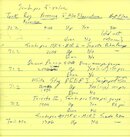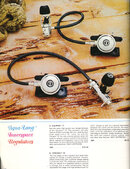It's a J valve that has the lever, not a k valve, which is a standard valve. It's not an emergency feature. It was there to be used in every dive as an indicator of when the pressure dropped to about 600 psi. When it did air was slowly cut off until you pointed it down with an actuator rod. This is what we did before SPGs became available.That's some relic hardware you got there and it's in great shape. They even have an integrated pressure gauge (the windows with the F, 1/2, E). I would removed them and service them before use but they look in working conditions. I have two tanks with K valve and they work just fine as long as the emergency valve is pointing down to keep the chamber open all the time. Never had an issue (knocking on wood)
You are using an out of date browser. It may not display this or other websites correctly.
You should upgrade or use an alternative browser.
You should upgrade or use an alternative browser.
Vintage or junk?
- Thread starter Coztick
- Start date
Please register or login
Welcome to ScubaBoard, the world's largest scuba diving community. Registration is not required to read the forums, but we encourage you to join. Joining has its benefits and enables you to participate in the discussions.
Benefits of registering include
- Ability to post and comment on topics and discussions.
- A Free photo gallery to share your dive photos with the world.
- You can make this box go away
- Messages
- 5,141
- Reaction score
- 4,150
- # of dives
- 5000 - ∞
@Coztick
I am concerned with your title
"Vintage or Junk ?"
Just a little over 70 years ago recreational SCUBA diving was introduced the US, in the December 1948, article in the now defunct magazine Science Illustrated by the late great James Dougan via an article titled "First of the menfish"
All diving equipment will age- it becomes old but it never becomes JUNK !
It is so important - mandatory- that we in the present preserve what remains of the present for the future generations. You SCUBA Pro valve is old but not JUNK !
SDM
@Luis H
@octoman
@John C. Ratliff
@Rol diy
@Akimbo
@Marie13
I am concerned with your title
"Vintage or Junk ?"
Just a little over 70 years ago recreational SCUBA diving was introduced the US, in the December 1948, article in the now defunct magazine Science Illustrated by the late great James Dougan via an article titled "First of the menfish"
All diving equipment will age- it becomes old but it never becomes JUNK !
It is so important - mandatory- that we in the present preserve what remains of the present for the future generations. You SCUBA Pro valve is old but not JUNK !
SDM
@Luis H
@octoman
@John C. Ratliff
@Rol diy
@Akimbo
@Marie13
Why "beware"? The J-valve simply functions well to give you a warning that you are low on air. If you "accidentally" put it in the functioning position, you can see that with a variation in the SPG, as the restriction will cause the SPG/computer to fluctuate in pressure levels. Here are some measurements I have made on the Scubapro J-valve and its fluxuations in pressure using different regulators. You will note that the Scubapro Mk V/AIR I combo did not have this fluxuation in pressures. Also, there is no fluxuation with a twin tank manifold, as the J-valve is over just one tank (this would not be true if the J-valve was mounted on the regulator first stage, such as with a Calypso "J" regulator).On different valves I have removed the guts as well,
or if I am really lazy, I have used electrical tape and tape the knob to the steel beside it, so it can't accidentally be activated,,, that does seem to work fine,,,,
But beware,,,,
SeaRat
Attachments
Gone for diving
Contributor
Oh I have no problems with J valves,Why "beware"? The J-valve simply functions well to give you a warning that you are low on air. If you "accidentally" put it in the functioning position, you can see that with a variation in the SPG, as the restriction will cause the SPG/computer to fluctuate in pressure levels. Here are some measurements I have made on the Scubapro J-valve and its fluxuations in pressure using different regulators. You will note that the Scubapro Mk V/AIR I combo did not have this fluxuation in pressures. Also, there is no fluxuation with a twin tank manifold, as the J-valve is over just one tank (this would not be true if the J-valve was mounted on the regulator first stage, such as with a Calypso "J" regulator).
SeaRat
I was more, beware if you tape it open, instead of removing the guts,
It could move on you,
That has been my quick hack if I want the j valve to stay open,
I also have a few times the lever was left up when I was filling tanks, and it didn't fill the one tank on my small double 60s,
But that's more operator error( my fault ).
NEVER ASSUME, because when you do,
It might bite You,
mictrik
Contributor
Just noticed this thread a year late but had a laugh. Last year I serviced seven of these valves and use them on my 2250 cylinders which I still find as the most comfortable to use for shore diving. There is a fine proprietary O-Ring that tends to leak air indicating service time. The pin gauge is calibrated for a 2250 cylinder but may of been able to be calibrated for other pressures. I have a few original Scubapro replacement burst disks that are 3000 psi. A very well built valve that are smooth and full of unique features. The j valve leaver is reversible where down would be dive and would be in "reserve".
Rather than reverse the lever, reorient it. This valve will allow the on-reserve “up” position to be pointed toward the diver’s back, rather than outward. This position precludes it being inadvertently tripped, but also necessitates using another means to hold the pull rod, as all the backpacks have the pull rod holder on the tank’s strap, and those are not movable.Just noticed this thread a year late but had a laugh. Last year I serviced seven of these valves and use them on my 2250 cylinders which I still find as the most comfortable to use for shore diving. There is a fine proprietary O-Ring that tends to leak air indicating service time. The pin gauge is calibrated for a 2250 cylinder but may of been able to be calibrated for other pressures. I have a few original Scubapro replacement burst disks that are 3000 psi. A very well built valve that are smooth and full of unique features. The j valve leaver is reversible where down would be dive and would be in "reserve".
 IMG_1024 by John Ratliff, on Flickr
IMG_1024 by John Ratliff, on FlickrJ-reserve lever in the normal, up position (reserve on).
 IMG_1022 by John Ratliff, on Flickr
IMG_1022 by John Ratliff, on FlickrJ-reserve lever in the reversed, up position (reserve on).
SeaRat
mictrik
Contributor
It seems I'm not the only fan of this valve.Rather than reverse the lever, reorient it. This valve will allow the on-reserve “up” position to be pointed toward the diver’s back, rather than outward. This position precludes it being inadvertently tripped, but also necessitates using another means to hold the pull rod, as all the backpacks have the pull rod holder on the tank’s strap, and those are not movable.
IMG_1024 by John Ratliff, on Flickr
J-reserve lever in the normal, up position (reserve on).
IMG_1022 by John Ratliff, on Flickr
J-reserve lever in the reversed, up position (reserve on).
SeaRat
- Messages
- 8,616
- Reaction score
- 7,320
- # of dives
- 2500 - 4999
I've got a few but none in service

as I like to do this
as I like to do this
mictrik
Contributor
That's A Dacor branded J valve not the Scubapro DCAR valve. Both are J valves but the DCAR has an adjustable reserve and is depth compensating by adding to reserve with greater depth. The DCAR also has a pin gauge that indicates cylinder fill status. I also have the same Dacor valve in your picture and it is just as smooth functioning as when new 40 years ago.
I know it’s a great selling point, but I think Fred Roberts in his book, Basic Scuba, made clear that all J-valves are depth-compensating by the nature of the valve.That's A Dacor branded J valve not the Scubapro DCAR valve. Both are J valves but the DCAR has an adjustable reserve and is depth compensating by adding to reserve with greater depth. The DCAR also has a pin gauge that indicates cylinder fill status. I also have the same Dacor valve in your picture and it is just as smooth functioning as when new 40 years ago.
SeaRat
Similar threads
- Replies
- 2
- Views
- 662
- Replies
- 3
- Views
- 932
- Replies
- 2
- Views
- 543





